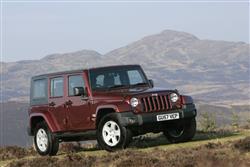Home | Used Car Road Tests | 4x4s | Jeep Wrangler JK series (2007-2017)
Road Test Video
Used Car Model Guide | Jeep Wrangler (2007 - 2017)
I JUST WRAN
By Steve Walker
You might well be able to trace the Jeep Wrangler's noble bloodline back to World War Two but is that really something to be celebrated in the modern motoring era? Jeep fans will be angrily fixing bayonets at the very suggestion that the Wrangler is anything other than an American hero. The rest of us could easily view it as a bit of an anachronism. So what is the truth and should UK car buyers consider a used Wrangler alongside the myriad other 4x4s out there for similar money?
History
We could set out on a detailed history of the Jeep Wrangler starting with the 1938 Willys Jeep but we'd still be here well into the next century. Instead, we're concentrating on the 2007 iteration, a vehicle that aimed to blend the classic Wrangler look and feel with newfangled modern excesses like interior space, ride comfort and fuel economy. This model was launched in the Spring of 2007, replacing the previous generation Wrangler which had been on sale in the UK for a decade and had grown conspicuously irrelevant by the time the axe fell.
The all new 2007 model arrived with the old 4.0 V6 petrol engine and a 2.8-litre CRD diesel but the aging petrol unit that could only muster 174bhp from its six cylinders and quartet of litres was swiftly replaced by a more modern 3.8-litre 196bhp unit. The range was split between the short wheelbase two-door, soft-top models which more closely adhere to the iconic Wrangler formula and five-door, long wheelbase cars with fixed roofs and the feel of a rather uncompromising family 4x4.
What You Get
Jeep was never about to change the Wrangler's styling too drastically. Round lights, the Jeep seven-slatted grille, trapezoidal wheel arches, external door hinges and rubber bonnet catches are all present and correct on this car. The Wrangler looks properly butch then, but the difference is it's bigger in this guise. Even on the short wheelbase model, the cabin is larger in all dimensions and a fold and tumble feature for the rear seat virtually doubles the available cargo capacity. For the first time in the car's history, it also received a curved glass windscreen to reduce drag and help refinement.
The bad news is that in building the Wrangler, Jeep remained intent on showing Korean manufacturers how cheap interior plastics can feel if proper corporate commitment and resolve is directed at the task. The 'Freedom Top' roof also requires an entire page of instructions to remove, which would appear to make it a once a twelve month job. A simpler folding soft top was offered but only as an aftermarket accessory. Ergonomics are patchy, with electric window switches on the fascia and door mirrors that you need to prod the glass with your finger to adjust. Despite this, the Wrangler remains a big-hearted and likeable thing.
What You Pay
Please contact us for an exact up-to-date valuation.
What to Look For
More than half a century of ongoing development has engineered a degree of toughness into the Wrangler. Able to make a Cherokee look vaguely limp wristed when the going gets really rough, the Wrangler is a hardy companion. Faults are few and far between. As with all serious off-roaders, check for damage to wheels and suspension. The underbody and wheelarch liners should be unsullied, and intrusive transmission whine can mean a new differential. Check the steering for play and also check all oil seals.
Replacement Parts
(Estimated prices, based on a 2007 2.8 Sport) A clutch assembly is around £3,000 and a full exhaust system around £700, including catalyst. Front brake pads are around £40 and a broken front radiator will be £400 or so.
On the Road
Just about the only way we can describe the ride of the previous generation Wrangler to the uninitiated is to imagine being stricken with a rather severe case of haemorrhoids and then being superglued to a spacehopper. Perhaps that's a tad harsh but after the novelty of the old car's bouncy ride had worn off, you were left with a vehicle that could crawl through deep mud but which wasn't much good at anything else. This version at least rides in a relatively composed manner on road, with halfway acceptable refinement at borderline illegal motorway speeds and it doesn't pogo horribly over bumps. Of course, it's still brilliant off road with even more aggressive approach and departure angles. Opt for the entry-level Sport or Shara trims and the car comes with clever brake lock differentials. The range-topping Rubicon model gets even more specialist front and rear locking differentials.
As long as you go for the two-door variant, two engines are offered. There's a 2.8-litre 174bhp CRD diesel that's a little vocal but punchy enough to get to 60mph in 10.9s and on to 112mph. Alternatively, there's a 3.8-litre petrol engine that's fitted to the range-topping Rubicon which didn't exactly fly out of showrooms. Better steering, brakes and suspension give this Wrangler an element of civility. The five-door car is only available with the diesel engine.
Overall
The Jeep Wrangler is only ever going to appeal to a certain type of owner, someone who buys into the heritage and rugged charm. The rest of us probably won't understand it as numerous other 4x4 vehicles perform everyday duties so much better but serious off-road vehicles are few and far between and the Jeep Wrangler will always be one of the best in that regard.
Related Road Tests
Browse the other models
Currently viewing Used Car Road Tests, switch to New Car Road Tests
Select a model to browse through the videos.
